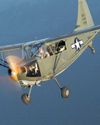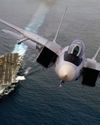Essayer OR - Gratuit
Perennial Bad Guy: The MiG-21 65 Years Old And Still Kickin' Butt
Flight Journal
|December 2018
If the United States has developed fighters that have staying power over many yearsthe venerable F-4, F-15, and F-16 come to mindthen the Russian MiG-21 must surely share that space. The MiG21 made its public debut in a Soviet air display in 1956. Known as an air-to-air missile fighter, the MiG-21 can also wage war with an internally mounted 23mm cannon. Some like to call the MiG21 the AK-47 of jet fighters. Like the famed short Soviet rifle, the MiG-21 has proven to be both lethal and long-lived around the world.

Just as avionics and weapons updates have kept the F-15 and F-16 potent into the 21st century, the venerable MiG-21 has been the subject of upgrades that keep it in contention today. The Soviets readily exported MiG-21s to many nations, from Europe to Asia. MiG-21s still serve at least 15 countries worldwide, ranging from Cuba to Croatia and Romania.
The basic MiG-21 was conceived as a short-range interceptor relying on ground radars for vectoring to its aerial target. Under these circumstances, the MiG-21's prominent shock cone nose inlet, which inhibited the use of long-range onboard radar, was not viewed as a detriment. The MiG-21 is a lightweight fighter that achieves Mach 2 and enjoys good maneuverability. It is sometimes compared to the F-5 and F-104 in performance.
MiG-21 Development
The progenitor of all MiG-21s the prototype called “Ye-2,” an ambitious jet with a swept wing. It first flew on a February day in 1955. Performance fell short of the intended Mach 2 speed, and the design evolved into a delta-wing planform, retaining a traditional horizontal tail as well. Subsequent test iterations up to Ye-6 yielded the basic MiG-21 form. By 1959–60, the Soviet Air Force was flying a small batch of MiG-21F variants armed with two 30mm cannons. This model carried the Soviet Air Force designation “Type 72” and the NATO identification name of “Fishbed B.”

Cette histoire est tirée de l'édition December 2018 de Flight Journal.
Abonnez-vous à Magzter GOLD pour accéder à des milliers d'histoires premium sélectionnées et à plus de 9 000 magazines et journaux.
Déjà abonné ? Se connecter
PLUS D'HISTOIRES DE Flight Journal

Flight Journal
ELLIPTICAL ELEGANCE
Flying and evaluating the Seafire Mark III
4 mins
November - December 2025

Flight Journal
IRON DOG
Fighting the Pacific and the P-39 at the same time
14 mins
November - December 2025

Flight Journal
Fighter Pilots: A Warrior Clan
TAKE A HARD LOOK at the two young men in these photos. Do they look as if they were bent on killing one another? On the left we have a young, unknown enlisted Japanese pilot standing in front of a Nakajima Ki-27 \"Nate,\" one of Japan's earliest monoplanes that led to the much vaunted Zero.
3 mins
November - December 2025

Flight Journal
KEN WALSH THE FIRST CORSAIR ACE
Medal of Honor pilot's combat adventures
12 mins
November - December 2025

Flight Journal
Big Chief's Little Chief
Thunderbolt action with the Wolf Pack
11 mins
November - December 2025

Flight Journal
ENEMY PILOTS SPEAK Voices from the other side
All too often American students of air warfare forget that enemy aircraftwhether Messerschmitts or MiGs-were flown by human beings with the same motivations and traits as Allied airmen. More often than not, the only difference between friend and foe was the paint on the airplane and where they landed. Therefore, we've assembled a variety of accounts from WW II Axis fighter pilots, men who were more than simply targets.
11 mins
November - December 2025

Flight Journal
FLYING THE FW 190
A legend gets checked out in the Butcher Bird
15 mins
November - December 2025

Flight Journal
DOUBLE-THEATER ACE
The fearless missions of legendary fighter pilot Col. John D. Landers
12 mins
November - December 2025

Flight Journal
WARBUG IN THE PACIFIC
Surviving combat in a Stinson OY-1/L-5
10 mins
September - October 2025

Flight Journal
WINGS OF THE FLEET
Celebrating the U.S. Navy's 250-year legacy
9 mins
September - October 2025
Translate
Change font size

